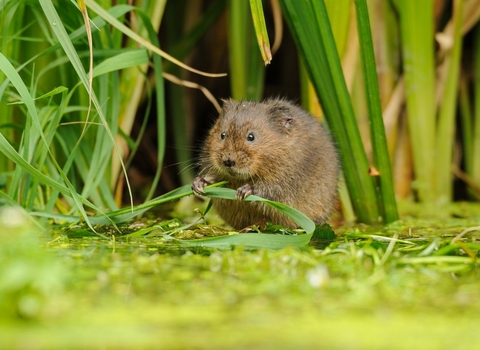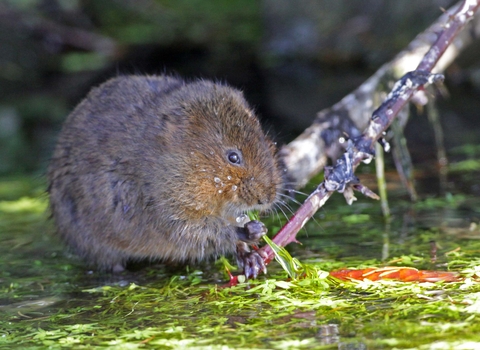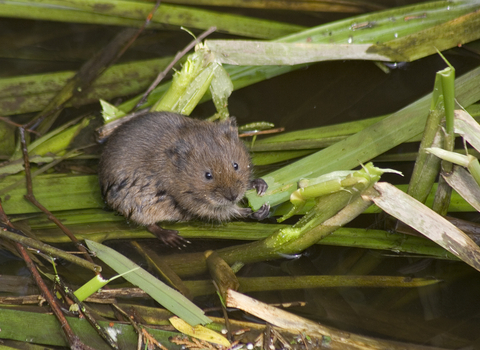
Terry Whittaker/2020VISION

©Margaret Holland
Water vole
Scientific name
Arvicola amphibiusWhen to see
January to DecemberSpecies information
Category
Statistics
Length: 14-22cmTail: 9.5-14cm
Weight: 150-300g
Average lifespan: 0.5-1.5 years
Habitats
About
The water vole lives along rivers, streams and ditches, around ponds and lakes, and in marshes, reedbeds and areas of wet moorland. Look out for the signs of water voles, such as burrows in the riverbank, often with a nibbled 'lawn' of grass around the entrance.Water voles like to sit and eat in the same place, so piles of nibbled grass and stems may be found by the water's edge, showing a distinctive 45 degree, angled-cut at the ends. 'Latrines' of rounded, cigar-shaped droppings may also be spotted. Water voles start to breed in spring, having three to four litters a year of up to five young.
How to identify
The water vole has chestnut-brown fur, a blunt, rounded nose, small ears, and a furry tail. It is much bigger than other vole species. Scotland’s water voles often appear darker, with many having a black coat.The similar brown rat is larger, with grey-brown fur, a pointed nose, large ears that protrude from its fur, and a long, scaly tail.
Distribution
Still widespread throughout mainland UK, though range and numbers have significantly declined. Absent from the Channel Islands, Isles of Scilly, Scottish islands, Northern Ireland and the Isle of Man.In our area
Survey work since 2006 has shown that the Whitchurch - Whixall area continues to be a national hotspot for water voles. The Whitchurch Community Water Vole Project is one of the partners who undertake habitat work to help water voles. It is important to increase the amount of good quality and inter-connected habitat in and and around areas where water voles are known to occur.
Water voles are often seen on the brook running through Greenfields nature reserve in Whitchurch but are even easier to spot on the watercourse running through the local Tesco car park. Further south in the county, water voles have been discovered inhabiting the streams around Church Stretton in 2019.
Did you know?
The water vole is famously known as 'Ratty' in Kenneth Grahame's classic children's tale, The Wind in the Willows. Despite being sometimes referred to as a 'water rat', there is no such thing - there are brown rats, black rats and water voles.Survey work since 2006 has shown that the Whitchurch - Whixall area continues to be a national hotspot for water voles. The Whitchurch Community Water Vole Project is one of the partners who undertake habitat work to help water voles. It is important to increase the amount of good quality and inter-connected habitat in and and around areas where water voles are known to occur.
Water voles are often seen on the brook running through Greenfields nature reserve in Whitchurch but are even easier to spot on the watercourse running through the local Tesco car park. Further south in the county, water voles have been discovered inhabiting the streams around Church Stretton in 2019.

